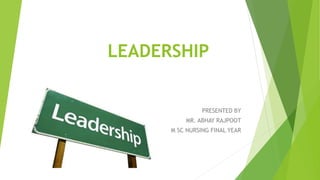
Leadership
- 1. LEADERSHIP PRESENTED BY MR. ABHAY RAJPOOT M SC NURSING FINAL YEAR
- 2. DEFINITION LEADER The person who leads or commands a group, organization or country. LEADERSHIP Leadership is the ability to influence other people Lansdale Leadership is the ability of a manager to induce subordinate to work with zeal confidence. Koontz and O Donnell
- 4. Planner Executive Policy maker Expert External group representative Controller of internal relation Purveyor of rewards and punishment
- 5. TYPES OF LEADER A) Intellectual leader B) Creative leader C) Persuasive leader D) Institutional leader E) Democratic leader F) Autocratic leader
- 7. TRAIT THEORY/GREAT MAN THEORY- This theory suggests that leaders have some inborn traits. They have certain set of characteristics that are crucial for inspiring others towards a common goal. A successful leader is supposed to have the following traits- good personality, tirelessness, capacity to read other‘s mind, ability to make quick decision, courage, persuasion, intelligence, reliability, imagination
- 8. STYLE THEORY- This focuses on what leaders do in relational and contextual terms. The achievement of satisfactory performance measures requires supervisors to pursue effective relationships with their subordinates, while comprehending the factors in the work environment that influence outcomes.
- 9. TRANSACTIONAL/TRANSFORMATIONAL THEORY This theory describes the relationship between leaders and followers. New concepts such as empowerment, inspiration motivation and social learning are present. This refers to a process whereby the leader attends to the needs and motives of followers so that interaction raises to high levels of motivation and morality.
- 10. SITUATIONAL THEORY This theory believes that leadership effectiveness depended on the relationship among the leaders task at hand, their interpersonal skills and the favorableness the work situation.This theory considers the challenge of situation and encourages an adaptive leadership style to complement the issue being faced.
- 12. AUTOCRATIC LEADERSHIP: Leader assumes complete control over the decisions and activities of the group. CHARACTERISTIC OF THE LEADER Firm personality, insistent, self-assured, highly directive, dominating. Shows no regards to the interests of the employees Set rigid standards and method of performance and expects the sudordinates to obey the rules and follow the same Makes all decision by himself or herself Minimal group participation or none from the workers
- 14. CONT.. ADVANTAGES Efficient in time of crisis, easy to make decision by one group and less time consuming It is useful when the workers are unsure of taking decision and expect the leader to tell what to do DISADVANTAGES Does not encourage the individuals growth and does not recognize the potentials, imitativeness and creates less cooperation among members Leader lacks supportive power that results in decision made with consultation although he may be correct Less job satisfaction leads to less commitment to goals of the organization
- 15. 2.DEMOCRATIC LEADERSHIP Participative consultative style of leadership CHARACTERISTIC OF THE LEADER Sense of equality among leader and followers Open system of communication prevails Interaction between the leader and group is friendly and trusting Leader works through people not by domination but by suggestions and persuasions ADVANTAGES Encourages all employee in decision making Promotes personnel involvement, greater commitment to work and enhance job satisfaction DISADVANTAGES It takes more time for taking decision by the group than the leader alone
- 16. LAISSARE-FAIRE LEADERSHIP Free- Rein, Anarchic and Ultraliberal style of leadership. The leader gives up all power to the group. CHARACTERISTIC FEATURES Encourages independent activity by the group member Group members are free to set their own goals determine their own activities and allowed to do almost what they desire.
- 17. CONT… ADVANTAGES In limited situations creativity may be encouraged for specific purposes To try new method of action DISADVANTAGES May lead to instability, disorganization, inefficiency, no unity of action Lack of feeling responsible to solve the problem that may arise. Individual will lose interest, initiative and desire for achievement
- 18. BUREAUCRATIC LEADERSHIP In this the leader function only with rules and regulations.Leader cannot be flexible and does not like to take any risk out of the rules. E.g defense leader Characteristics of leadership 1. Its style may differ from situation to situation. 3. It involves an unequal distribution of authority among leaders and groups.
- 19. LEADERSHIP SKILLS SKILLS OF PERSONAL BEHAVIOUR Sensitive to the feeling of the group Identifies self with needs of the group Does not argue SKILLS OF COMMUNICATION Listen attentively Make sure everyone understands Establish positive communication with the group Recognizes that everyone‘s contribution are important
- 20. CONT… SKILLS OF ORGANIZATION Develop short and long term objectives Break big problem into small ones Share responsibilities and opportunities Plan, act, follow-up and evaluate SKILLS OF SELF EXAMINATION Aware of personal motivation Aware of group members Helps group to aware of their attitudes and values S- Self reliant E- enthusiastic L- Loyal F- Factual
- 21. APPLICATION OF LEADERSHIP IN NURSING 1 Patient care coordination 2 Employee responsibilities 3. Guidelines for delegating nursing care 4. Mentorship 5. Preceptor ship 6. Continuing education
- 22. SUMMARY
- 23. CONCLUSION In a long-term care facility, nurse leaders are constantly on the move. As a result, many nurse leaders naturally adopt a leadership style known as Management by Walking Around (MBWA) or Leading by Walking Around (LBWA.) In addition to checking on clinical issues and keeping the environment looking homelike, MBWA gives you the opportunity to: Observe team members interacting with residents and families Let staff know that leader is interested in them and their work Evaluate the quality of care being delivered Demonstrate leaders interest in daily operations
- 24. ASSIGNMENT Difference between management and leadership
- 25. BIBLIOGRAPHY https://www.mindtools.com/pages/article/newLDR_41.htm https://www.psychologytoday.com/us/basics/leadership https://www.forbes.com/sites/kevinkruse/2013/04/09/what-is-leadership https://www.powershow.com/viewfl/599645- Yzc5N/Nursing_Leadership_and_Management_powerpoint_ppt_presentation www.slideworld.org/slidestag.aspx/nursing-leadership-and-management
- 26. THANK YOU
